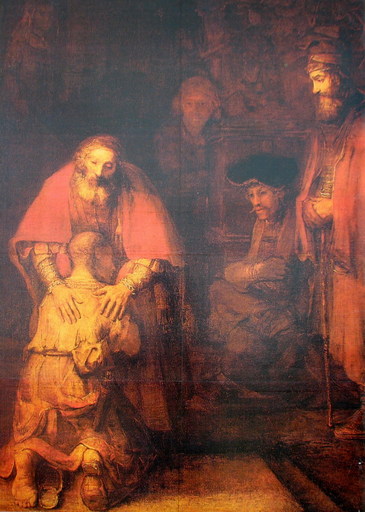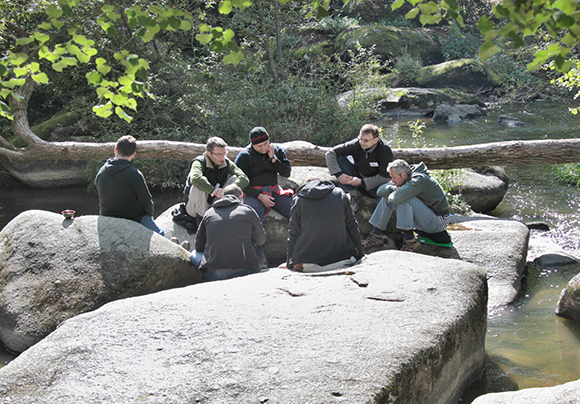
Starý muž, který se neumí smát, je trouba.
Richard Rohr
Kdo jsme?
Tento web reprezentuje hnutí Chlapi, neformální společenství mužů, kteří hledají takové způsoby duchovního prožívání, se kterými se dokážou jako muži ztotožnit a celou bytostí je žít.
Můžeš se tady setkat s muži, kteří usilují o to být lepšími a více autentickými.
Vytváříme jak reálný tak virtuální prostor pro setkávání.
Začalo to někdy před rokem 2000 hledáním mužské energie, spirituality i chlapské party a setkáváním v malých skupinách. Pokračovalo to inspirací dílem Richarda Rohra a jeho Rituálem pro přechod do zralé dospělosti a pokračuje to dodnes stovkami setkání v malých skupinách, víkendovými akcemi pro muže i pro otce a děti, rituály i celostátními setkáními pro stovky účastníků a mezinárodní spoluprací s hnutím mužů po celém světě.
Pro řadu z nás je podstatné přátelství s Bohem, pro všechny jsou oporou kamarádi, které tu nalezli.
Vítáme tě mezi námi a těšíme se na společné putování.

Pavel Hrdina a Martin Šmídek
Překlad meditace CAC z neděle 2. 11. 2025
na téma:
Život podle Kázání na hoře
| Vede nás k něčemu novému Otec Richard Rohr píše o radikálním poselství Kázání na hoře. Ježíš ve svém učení, a zejména v Kázání na hoře, kritizuje a přeuspořádává hodnoty své kultury zdola nahoru. "Zrazuje" převládající instituce rodiny, náboženství, moci a kontroly zdrojů svou věrností jiné vizi světa, kterou nazývá Boží vládou. Tato loajalita ho stojí všeobecnou popularitu, podporu autorit, nesmírné vnitřní utrpení a nakonec i vlastní život. Zasazením obrazu do největšího možného rámce zpochybňuje všechny menší rámce a vyzývá své posluchače k radikální proměně vědomí. Mnozí na ni nebyli připraveni - stejně jako mnozí z nás dnes. Chceme-li porozumět Kázání na hoře, musíme si ujasnit, kam nás Ježíš vede .Není to ke starému já na staré cestě, což by znamenalo neobrácení a neosvícení. Není to ke starému já na nové cestě, což je místo, kde většina náboženství začíná a končí. Zahrnuje nové chování, nový jazyk a praktiky, které jsou sice upřímné, ale základní mýtus/světonázor/motivace a cíle se ve skutečnosti nikdy nezmění. Můj hněv, strach a ego jsou pouze přeneseny na to, aby nyní hájily mou představu Boha nebo náboženství. Ježíš nás vede k novému já na nové cestě, která je celkovou proměnou vědomí, světonázoru, motivace, cílů a odměn, jež charakterizují toho, kdo miluje a je milován Bohem. Matouš připravuje půdu pro kázání třemi jednoduchými větami: "Když uviděl zástupy, vystoupil na horu. Když se posadil, přistoupili k němu jeho učedníci. Pak začal mluvit" (Mt 5,1-2). Vzpomeňte si, že Mojžíš sestoupil z vrcholu hory s Desaterem. Pro Matoušovo židovské publikum je poselství jasné: Toto je nový Mojžíš, který se vrací na vrchol hory, znovu hlásá pravdu a přináší nový zákon. To je velmi důležitý kontext: Kázání je v jistém smyslu Ježíšovou revizí Desatera. Blahoslavenství (někdy překládaná jako "šťastné postoje" nebo dokonce blahopřání v laickém smyslu) nejsou adresována zástupům, ale Ježíšovým učedníkům. Později v evangeliu je nejnáročnější učení - "vezmi svůj kříž" - vyhrazeno ještě menší skupině, dvanácti apoštolům. Kázání je určeno většímu druhému okruhu učedníků, těm, kteří jsou teprve zasvěcováni. To jsme my! Zdá se, že v Ježíšově zasvěcení je velmi reálný plán. Je si vědom načasování, připravenosti a zrání. V počátečních fázích nejsme připraveni na tvrdá slova evangelia, nejsme schopni slyšet poselství kříže. Teprve v druhé polovině života pochopíme, že umírání není v rozporu se životem. Umírání je součástí většího tajemství - a my jsme součástí tohoto tajemství. Podle mých zkušeností je to obvykle starší psychika, která je připravena slyšet takovou střízlivou pravdu. přeloženo DeepL | Leading Us Somewhere New
Father Richard Rohr writes about the radical message of the Sermon on the Mount. In his teachings, and in the Sermon on the Mount in particular, Jesus critiques and reorders the values of his culture from the bottom up. He “betrays” the prevailing institutions of family, religion, power, and resource control by his loyalty to another world vision, which he calls the reign of God. Such loyalty costs him general popularity, the support of the authorities, immense inner agony, and finally his own life. By putting the picture in the largest possible frame, he calls into question all smaller frames and invites his hearers into a radical transformation of consciousness. Many were not ready for it—nor are many of us today. To understand the Sermon on the Mount, we need to clarify where Jesus is leading us. It’s not to the old self on the old path, which would be non-conversion and non-enlightenment. It’s not to the old self on a new path, which is where most religion begins and ends. It involves new behavior, new language, and practices that are sincere, but the underlying myth/worldview/motivation and goals are never really changed. My anger, fear, and ego are merely transferred to now defend my idea of God or religion. Jesus is leading us to the new self on a new path, which is the total transformation of consciousness, worldview, motivation, goals, and rewards that characterize one who loves and is loved by God. Matthew sets the stage for the Sermon with three simple sentences: “Seeing the crowds, he went onto the mountain. And when he was seated his disciples came to him. Then he began to speak” (Matthew 5:1–2). Remember, Moses came down from the mountaintop with the Ten Commandments. For Matthew’s Jewish audience, the message is clear: This is the new Moses going back to the mountaintop, reproclaiming the truth, bringing down the new law. That is a very important context: In a certain sense, the Sermon is Jesus’ revisioning of the Ten Commandments. The Beatitudes (sometimes translated as “happy attitudes,” or even congratulations in a secular sense) are addressed not to the crowds but to Jesus’ disciples. Later in the Gospel, the most demanding teaching— “take up your cross”—is reserved for an even smaller group, the twelve apostles. The Sermon is addressed to the larger second circle of disciples, those who are still being initiated. That’s us! It seems there is a very real plan in Jesus’ initiation. He is aware of timing, readiness, and maturation. At the early stages, we are not ready for the hard words of the gospel; we are unable to hear the message of the cross. It is only in the second half of life that we come to understand that dying is not opposed to life. Dying is a part of a greater mystery—and we are a part of that mystery. In my experience, it is usually the older psyche that is ready to hear such sober truth. |
Zde se nacházejí překlady Daily Meditations, jejichž anglické originály se nacházejí na webu CAC. V den jejich vydání je zde nalezneš přeložené strojově pomocí DeepL, zpravidla do druhého dne pak projdou jazykovou úpravou někým z týmu překladatelů :-) Pokud vládneš dobrou angličtinou, přihlas se asi raději přímo u zdroje těchto úvah, tedy na webu CAC. Budeš je pak do své mailové schránky dostávat již k ranní kávě. -mš-
 Myšlenka Richarda Rohra na Třicátá druhá neděle v mezidobí - Tiší dostanou za dědictví zemi Vlastnictví je ve světle Božího království iluzí! Co vlastníš? Počkej si pár let! Kolik toho vlastníme, poznáme, až budeme šest stop pod zemí. Pouze tiší dostanou zemi za dědictví (viz Mt 5,4). Tiší se též překládá jako „skromní“, „pokorní“, dokonce jako „nenásilní“ nebo „bezmocní“. Jako františkán si připomínám, že …
Myšlenka Richarda Rohra na Třicátá druhá neděle v mezidobí - Tiší dostanou za dědictví zemi Vlastnictví je ve světle Božího království iluzí! Co vlastníš? Počkej si pár let! Kolik toho vlastníme, poznáme, až budeme šest stop pod zemí. Pouze tiší dostanou zemi za dědictví (viz Mt 5,4). Tiší se též překládá jako „skromní“, „pokorní“, dokonce jako „nenásilní“ nebo „bezmocní“. Jako františkán si připomínám, že …




